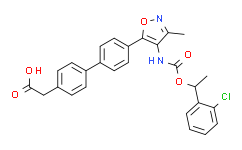AM966 is a potent, selective, orally bioavailable LPA1 receptor antagonist. AM966 inhibits LPA1-mediated chemotaxis of human A2058 melanoma cells (IC50=138±43 nM), IMR-90 human lung fibroblasts (IC50=182±86 nM) and CHO mLPA1 cells (IC50=469±54 nM). LPA-induced ERK1/2 activation is completely blocked by AM966 (100 nM), which selectively antagonizes LPA1 over LPA2-5, with an IC50 value of 3.8±0.4 nM. Pre-treatment with AM966 (100 nM) completely blocks ERK1/2 phosphorylation induced by Mianserin.
Medlife has not independently confirmed the accuracy of these methods. They are for reference only.



 扫码关注公众号
扫码关注公众号